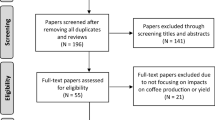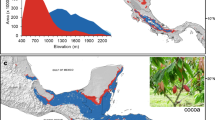Abstract
Coffee production is impacting the climate by emitting greenhouse gasses. Coffee production is also vulnerable to climate change. As a consequence, the coffee sector is interested in climate-friendly forms of coffee production, but there is no consensus of what exactly this implies. Therefore, we studied two aspects of the climate impact of coffee production: the standing carbon stocks in the production systems and the product carbon footprint, which measures the greenhouse gas emissions per unit weight of coffee produced. We collected data from 116 coffee farms in five Latin American countries, Mexico, Guatemala, Nicaragua, El Salvador, and Colombia, for four coffee production systems: (1) traditional polycultures, (2) commercial polycultures, (3) shaded monocultures, and (4) unshaded monocultures. We found that polycultures have a lower mean carbon footprint, of 6.2–7.3 kg CO2-equivalent kg−1 of parchment coffee, than monocultures, of 9.0–10.8 kg. We also found that traditional polycultures have much higher carbon stocks in the vegetation, of 42.5 Mg per ha, than unshaded monocultures, of 10.5 Mg. We designed a graphic system to classify production systems according to their climate friendliness. We identified several strategies to increase positive and reduce negative climate impacts of coffee production. Strategies include diversification of coffee farms with trees, the use of their wood to substitute for fossil fuel and energy-intensive building materials, the targeted use of fertilizer, and the use of dry or ecological processing methods for coffee instead of the traditional fully washed process.



Similar content being viewed by others
Notes
Only fuel wood replacing fossil fuel outside the coffee system (that is, not including coffee drying for example) would qualify for inclusion in the product carbon footprint to avoid double counting.
References
Babbar LI, Zak DR (1995) Nitrogen loss from coffee agroecosystems in Costa Rica: leaching and denitrification in the presence and absence of shade trees. J Environ Qual 24:227–233. doi:10.2134/jeq1995.00472425002400020003x
Beer J (1988) Litter production and nutrient cycling in coffee (Coffea arabica) or cacao (Theobroma cacao) plantations with shade trees. Agrofor Syst 7:103–114. doi:10.1007/BF00046846
BIOMAT (1992) Estudio y Diseño de la Planta de Tratamiento de los Desechos del Café en la Finca “San Luis”. Alcaldia de Matagalpa y Oficina Biogás y Saneamiento Ambiental, Matagalpa, Nicaragua
BSI (2008) Publicly Available Specification (PAS) 2050: Specification for the assessment of the life cycle greenhouse gas emissions of goods and services. British Standards Institution, London
Cadena G, Baker PS (2001) Sustainable coffee. In: Baker PS (ed) Coffee futures: A source book of some critical issues confronting the coffee industry. CABI-FEDERACAFE-USDA-ICO, Chinchina, pp 56–65
Cock JH, Álvarez DM, Estrada M (2010) Rapid soil and terrain assessment. Centro International de Agricultura Tropical (CIAT), Cali
Coltro L, Mourad A, Oliveira P, Baddini J, Kletecke R (2006) Environmental profile of Brazilian green coffee. Int J Life Cycle Assess 11:16–21. doi:10.1065/lca2006.01.230
Cortina-Villar S, Plascencia-Vargas H, Vaca R, Schroth G, Zepeda Y, Soto-Pinto L, Nahed-Toral J (2012) Resolving the conflict between ecosystem protection and land use in protected areas of the Sierra Madre de Chiapas, Mexico. Environ Manage 49:649–662. doi:10.1007/s00267-011-9799-9
Hergoualc'h K, Blanchart E, Skiba U, Hénault C, Harmand J-M (2012) Changes in carbon stock and greenhouse gas balance in a coffee (Coffea arabica) monoculture versus an agroforestry system with Inga densiflora, in Costa Rica. Agric Ecosyst Environ 148:102–110. doi:10.1016/j.agee.2011.11.018
Hillier J, Walter C, Malin D, Garcia-Suarez T, Mila-i-Canals L, Smith P (2011) A farm-focused calculator for emissions from crop and livestock production. Environ Model Software 26:1070–1078. doi:10.1016/j.envsoft.2011.03.014
Humbert S, Loerincik Y, Rossi V, Margni M, Jolliet O (2009) Life cycle assessment of spray dried soluble coffee and comparison with alternatives (drip filter and capsule espresso). J Clean Prod 17:1351–1358. doi:10.1016/j.jclepro.2009.04.011
IPCC (2007) Climate Change 2007: Impacts, adaptation and vulnerability. Cambridge University Press, Cambridge
Läderach P, Haggar JP, Lau C, Eitzinger A, Ovalle-Rivera O, Baca M, Jarvis A, Lundy M (2010) Mesoamerican coffee: Building a climate change adaptation strategy. CIAT Policy Brief No. 2. Centro Internacional de Agricultura Tropical, Cali
Moguel P, Toledo VM (1999) Biodiversity conservation in traditional coffee systems of Mexico. Conserv Biol 13:11–21. doi:10.1046/j.1523-1739.1999.97153.x
Nygren P, Fernández MP, Harmand J-M, Leblanc HA (2012) Symbiotic dinitrogen fixation by trees: an underestimated resource in agroforestry systems? Nutr Cycl Agroecosyst 94:123–160. doi:10.1007/s10705-012-9542-9
Pearson T, Walker S, Brown S (2005) Source book for LULUCF projects. Winrock International, Arlington
Perfecto I, Vandermeer J, Hanson P, Cartín V (1997) Arthropod biodiversity loss and the transformation of a tropical agro-ecosystem. Biodivers Conserv 6:935–945. doi:10.1023/A:1018359429106
Rice RA, Ward JR (1996) Coffee, conservation, and commerce in the western hemisphere. Smithsonian MIgratory Bird Center and National Resources Defence Council, Washington DC
Rodríguez N, Zambrano DA (2010) Los subproductos del café: fuente de energía renovable. Av Técnicos Cenicafé 393:1–8
Ruf F, Schroth G (2013) Cultures Pérennes Tropicales: Enjeux Économiques et Écologiques de la Diversification. Editions Quae, Montpellier
Schroth G, Ruf F (2014) Farmer strategies for tree crop diversification in the humid tropics. A review. Agron Sustain Dev. doi:10.1007/s13593-013-0175-4
Schroth G, da Silva LF, Seixas R, Teixeira WG, Macêdo JLV, Zech W (1999) Subsoil accumulation of mineral nitrogen under polyculture and monoculture plantations, fallow and primary forest in a ferralitic Amazonian upland soil. Agric Ecosyst Environ 75:109–120. doi:10.1016/S0167-8809(99)00068-7
Schroth G, Rodrigues MRL, D'Angelo SA (2000) Spatial patterns of nitrogen mineralization, fertilizer distribution and roots explain nitrate leaching from mature Amazonian oil palm plantation. Soil Use Manag 16:222–229. doi:10.1111/j.1475-2743.2000.tb00197.x
Schroth G, D'Angelo SA, Teixeira WG, Haag D, Lieberei R (2002) Conversion of secondary forest into agroforestry and monoculture plantations in Amazonia: consequences for biomass, litter and soil carbon stocks after seven years. For Ecol Manage 163:131–150. doi:10.1016/S0378-1127(01)00537-0
Schroth G, Läderach P, Dempewolf J, Philpott SM, Haggar JP, Eakin H, Castillejos T, Garcia-Moreno J, Soto-Pinto L, Hernandez R, Eitzinger A, Ramirez-Villegas J (2009) Towards a climate change adaptation strategy for coffee communities and ecosystems in the Sierra Madre de Chiapas, Mexico. Mitig Adapt Strateg Glob Chang 14:605–625. doi:10.1007/s11027-009-9186-5
Schroth G, da Mota MSS, Hills T, Soto-Pinto L, Wijayanto I, Arief CW, Zepeda Y (2011) Linking carbon, biodiversity and livelihoods near forest margins: The role of agroforestry. In: Kumar BM, Nair PKR (eds) Carbon sequestration in agroforestry: Processes, policy, and prospects. Springer, Berlin, pp 179–200. doi:10.1007/978-94-007-1630-8_10
Segura M, Kanninen M, Suárez D (2006) Allometric models for estimating aboveground biomass of shade trees and coffee bushes grown together. Agrofor Syst 68:143–150. doi:10.1007/s10457-006-9005-x
Somarriba E, Harvey CA, Samper M, Anthony F, González J, Staver C, Rice RA (2004) Biodiversity conservation in neotropical coffee (Coffea arabica) plantations. In: Schroth G, Fonseca GAB, Harvey CA, Gascon C, Vasconcelos HL, Izac A-MN (eds) Agroforestry and biodiversity conservation in tropical landscapes. Island Press, Washington, DC, pp 198–226
Somogyi Z, Teobaldelli M, Federici S, Matteucci G, Pgaliari V, Grassi G, Seufert G (2008) Allometric biomass and carbon factors database. iForest - Biogeosci For 1:107–113. doi:10.3832/ifor0463-0010107
Soto-Pinto L, Anzueto M, Mendoza J, Ferrer GJ, de Jong B (2010) Carbon sequestration through agroforestry in indigenous communities of Chiapas, Mexico. Agrofor Syst 78:39–51. doi:10.1007/s10457-009-9247-5
Tchibo (2008) Case Study Tchibo Privat Kaffee Rarity Machare. PCF Pilot Project Germany. Öko-Institut e.V, Berlin
UTZ Certified (2013) Energy from coffee waste in Central America. Pilot Project Central America. UTZ Certified, Amsterdam, Availabe from: https://www.utzcertified.org/nl/aboututzcertified/field-development/2373
Acknowledgments
This study was conducted under the CGIAR research program on Climate Change, Agriculture and Food Security (CCAFS). The fieldwork was carried out as a part of the Coffee Under Pressure (CUP) project funded by Green Mountain Coffee Roasters. We thank the coffee farmers and the staff from the organizations Apecafé, Acoderol, Prodecoop, Pronatura Sur, ECOM, and Neumann for their collaboration in the field data collection, as well as Jonathan Hillier, Jos van Hal, Stephanie Daniels, Diana Sophia Blackburn Cuero, and Katharina Plassmann for their advice during this study.
Author information
Authors and Affiliations
Corresponding author
About this article
Cite this article
van Rikxoort, H., Schroth, G., Läderach, P. et al. Carbon footprints and carbon stocks reveal climate-friendly coffee production. Agron. Sustain. Dev. 34, 887–897 (2014). https://doi.org/10.1007/s13593-014-0223-8
Accepted:
Published:
Issue Date:
DOI: https://doi.org/10.1007/s13593-014-0223-8




